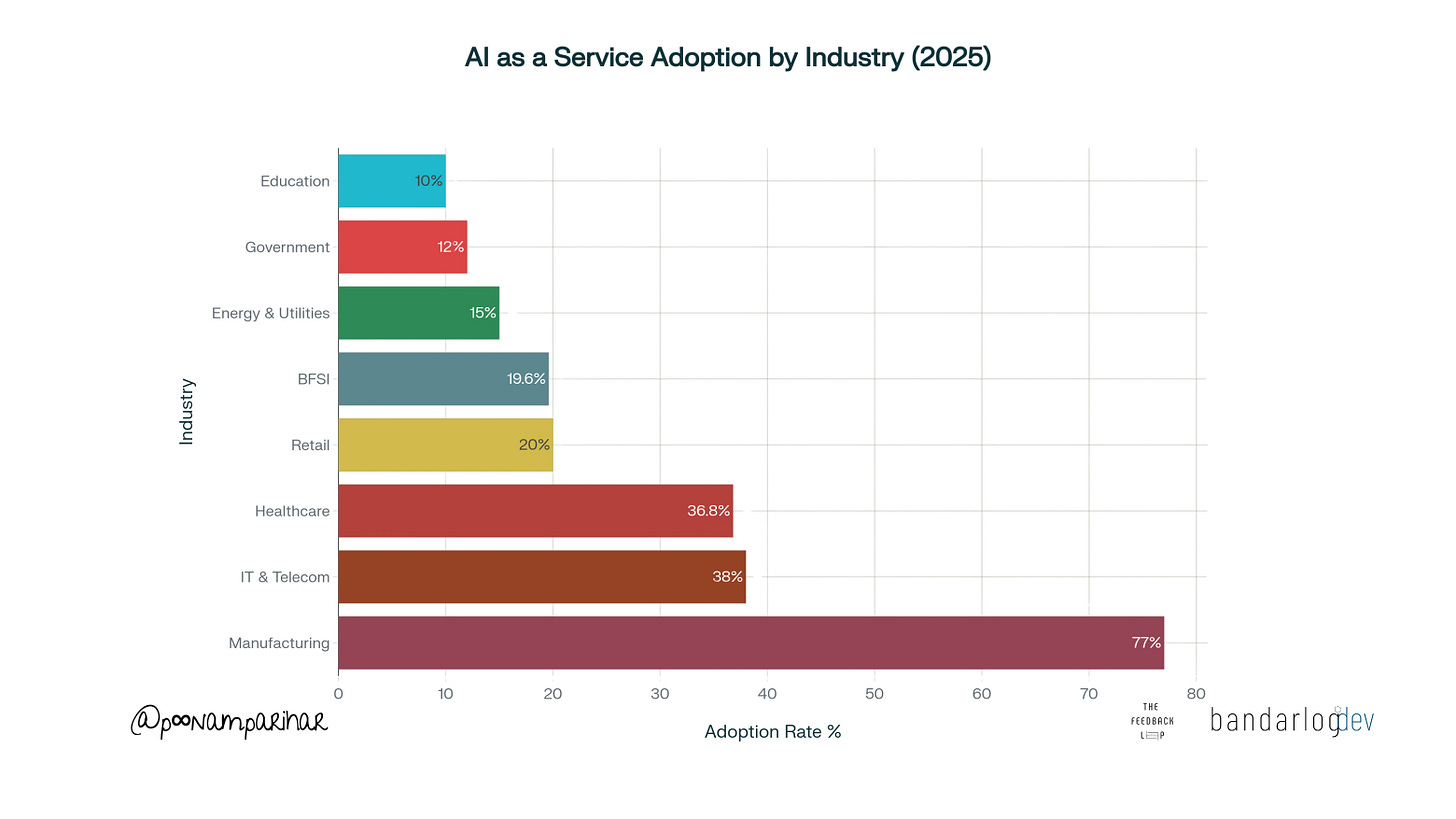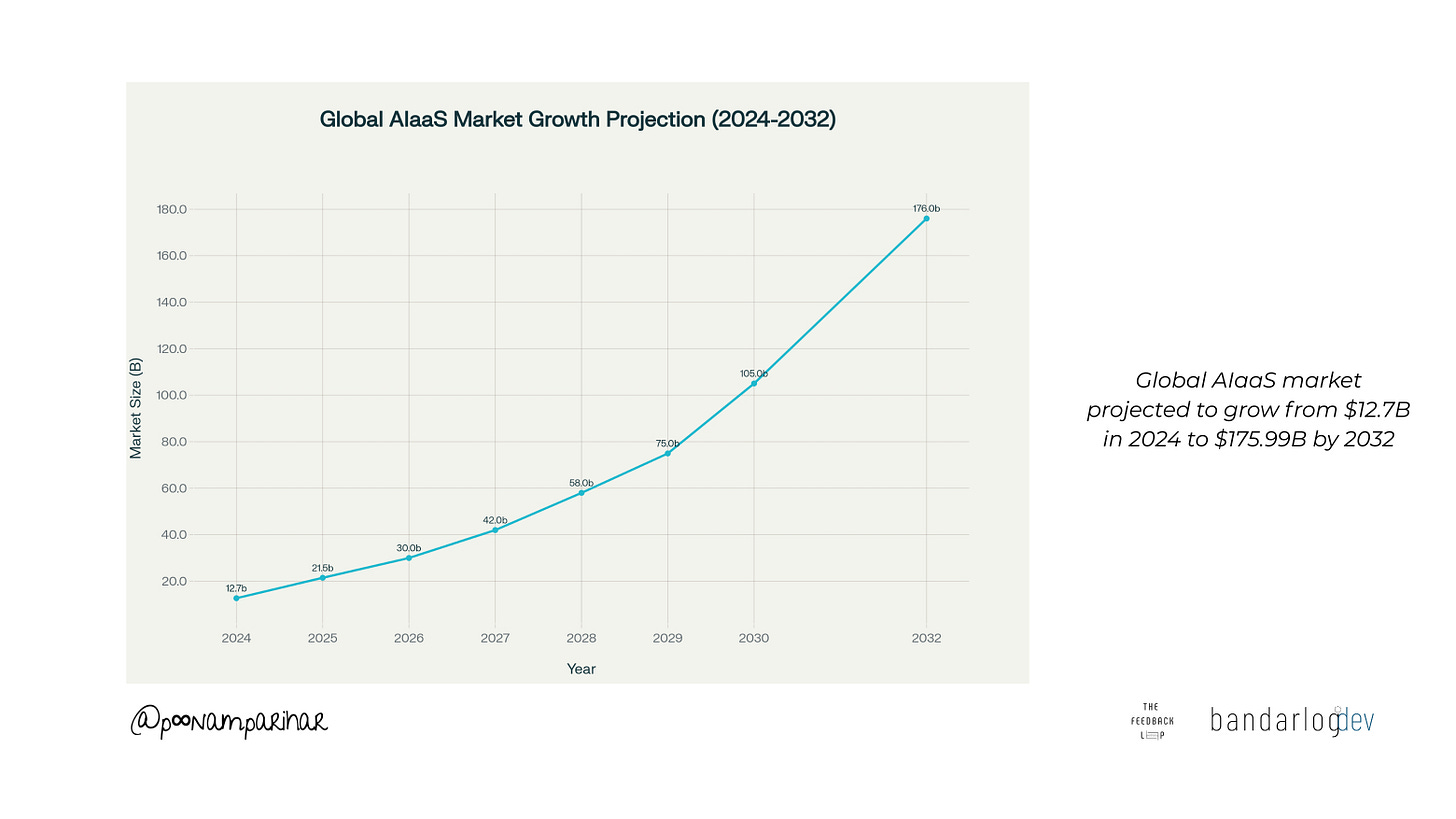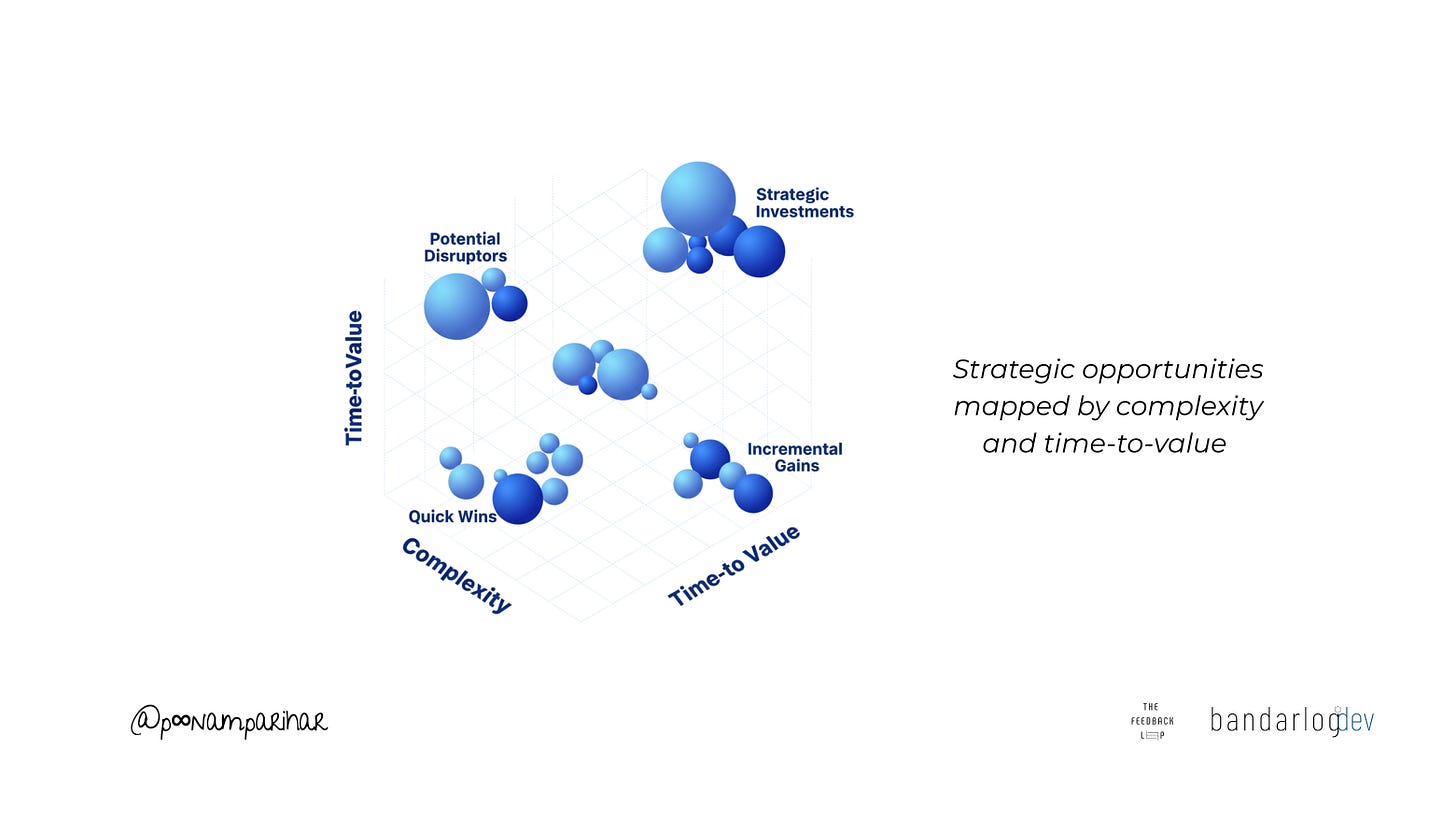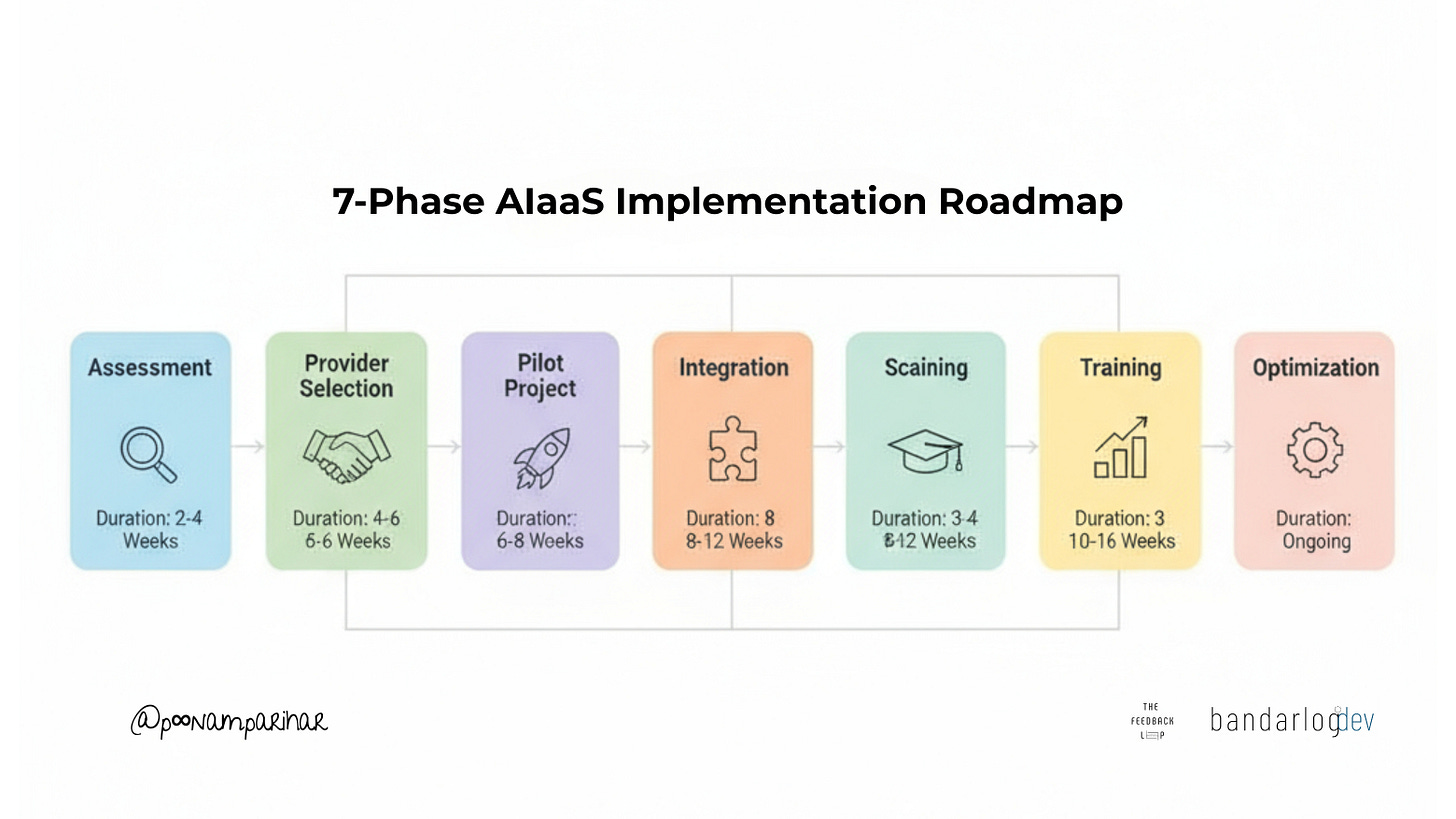Who’s Adopting AIaaS? Choosing the right partner and a practical roadmap from assessment to optimization
Market Explosion, The Top players? The AI as a Service (AIaaS) Journey: Your 7-Step Playbook for Implementation
The AI revolution is reshaping how businesses operate today and for founders and CEOs, navigating this complex landscape of AI adoption, AI as a Service (AIaaS) has emerged as the most pragmatic path forward. The global AIaaS market is projected to explode from $21.48 billion in 2025 to $175.99 billion by 2032, representing a compound annual growth rate of 35.1%. For startups and SMEs, this democratization of AI technology means competitive parity with industry giants without the prohibitive investment in data science teams or GPU infrastructure. AIaaS enables businesses to access enterprise-grade AI capabilities through cloud-based platforms at a fraction of traditional costs, with deployment timelines measured in weeks rather than months. For startups it means being able to compete with larger players by leveraging subscription-based or modular, plug-and-play AI tools.
In this blog I explore market intelligence, implementation strategies, and strategic opportunities specifically relevant to technology leaders and deep-tech founders of lean startups like me, looking to leverage AI without the cost and burden of building infrastructure from scratch.
Note - to keep the focus on the current deployment scenerios, I am skipping two important points, one is on-device AI and chip development, and other is the use cases of small language models.
Understanding AI as a Service: The Core Paradigm
AI as a Service delivers AI capabilities including machine learning, natural language processing (NLP), computer vision, and predictive analytics through cloud-based platforms accessible via APIs and web interfaces. which means rather than investing $250,000 to $1,000,000 in building custom AI models, businesses can leverage pre-trained algorithms and scalable infrastructure on a subscription or pay-as-you-go basis.
The AIaaS model transforms AI from a capital expenditure into an operational expense, fundamentally altering the economics of innovation. Organizations now deploy AI solutions in 2-4 weeks compared to 6-12 months for traditional custom development. This acceleration enables rapid prototyping, faster time-to-market, and the agility to pivot based on real-world performance data.
Market Landscape and Growth Trajectory
The AIaaS market demonstrates explosive growth across all forecasting models. According to Fortune Business Insights, the market will grow from $21.48 billion in 2025 to $175.99 billion by 2032. GM Insights reports the 2024 market valued at $12.7 billion with a projected CAGR of 30.6% through 2034. These projections reflect that 78% of organizations are now using AI in at least one business function up from 55% just one year earlier.
Regional dynamics reveal North America dominating with 38.7% market share in 2024, driven by advanced cloud infrastructure and significant R&D investment. However, the Asia-Pacific (APAC) region is expected to grow at the highest CAGR of 19.8% through 2034, fueled by rapid digitalization and expanding cloud infrastructure. Private investment patterns also underscore this momentum. In U.S. organizations invested $109.1 billion in AI during 2024 nearly 12 times China’s $9.3 billion.
Industry Adoption Patterns and Use Cases
AIaaS adoption varies dramatically across sectors, reflecting different maturity levels, regulatory environments, and use case readiness.
Manufacturing leads all industries with a 77% adoption rate in 2025, leveraging AI for predictive maintenance, quality control, and supply chain optimization. Companies report an average 23% reduction in downtime through AI-powered process automation.
IT and telecommunications follow with 38% adoption, focusing on network optimization and customer experience applications. The sector is projected to add $4.7 trillion in gross value through AI implementations by 2035.
Healthcare demonstrates 36.8% adoption with a remarkable compound annual growth rate, driven by breakthrough applications in diagnostics, patient management, and clinical documentation. AI-powered chatbots now handle initial patient inquiries in 42% of major healthcare networks.
Financial services allocate over $20 billion annually to AI technologies, with fraud detection as the primary use case. Investment firms show particularly aggressive adoption, with 68% of hedge funds employing AI for market analysis and trading strategies.
Retail businesses have increased AI investments to 20% of technology budgets up from 15% in 2024, with retailers deploying AI-driven chatbots reporting 15% increases in conversion rates during peak sales periods.
The AIaaS Provider Ecosystem
From hyperscale cloud giants to specialized AI platforms, the list of providers is huge and each bring in their unique strengths, tools, and enterprise capabilities. Choosing the right AI as a Service provider is critical to maximizing value and minimizing friction as you integrate AI into your business. Here’s the list of most prominent providers, with their signature features, and the business outcomes they deliver which can help the CEOs map the best fit for their company’s needs and ambitions.
Google Cloud AI
AutoML for fast custom model training and minimal coding required
AI Hub for centralized content, strong analytics & supply chain tools
Case study - Used by Procter & Gamble for personalized product offerings and unified data lake
AWS AI (Amazon Web Services)
Wide AI service portfolio: Rekognition (vision), Comprehend (NLP), SageMaker (ML models)
Case study - Serves BMW, Slack, virtual agents, conversational search, supply chain optimization
Free tier and flexible pricing for all business sizes
Microsoft Azure AI
Deep integration with Azure ecosystem and Office 365 suite
Azure AI Foundry models with lifecycle management, Cognitive Services for speech/vision
Case study - Empowered TomTom’s Digital Cockpit—shrinking team size and improving speed
IBM Watson
Enterprise-grade AI, strong on security & compliance (great for regulated industries)
Watson NLU, Watson Assistant (chatbots), Watson Discovery (unstructured data)
Case study - Legal Mation slashed legal drafting cost/time by 80% (from hours to under 2 mins)
Salesforce Einstein AI
Combines CRM, AI, and predictive analytics for personalized customer experience
Embedded chatbots, NLP, virtual assistants across all Salesforce clouds
Case study - Gucci uses Einstein for unified, brand-ready omnichannel advisor messaging
OpenAI
Famous for GPT-3, GPT-3.5, GPT-4, Language and generative models
API powers applications for emails, coding, content, Q&A, and image generation
Case study - Used by Stripe (user experience, fraud) and Duolingo (language learning)
Strategic Benefits and Value Proposition
AIaaS presents compelling advantages that fundamentally alter the AI adoption calculus.
Cost optimization represents the most immediate benefit reducing AI costs by 70-90% compared to in-house development. Traditional AI initiatives require $150,000-$300,000 annually per machine learning engineer, plus $50,000-$500,000 for GPU clusters and storage. AIaaS can transforms this capital expenditure model into operational expenses, with companies reporting 200-400% ROI within 12 months of implementation, compared to 18-36 months for custom projects.
Speed and agility accelerate competitive advantage. Financial services firms using AIaaS for fraud detection report deployment times of 2-4 weeks versus 6-12 months for custom solutions, achieving comparable or superior accuracy rates. This rapid prototyping capability enables businesses to test AI capabilities in days rather than months, leveraging billions of dollars in R&D investment through pre-trained models.
Scalability ensures infrastructure grows seamlessly with business demands. AIaaS platforms can handle demand spikes through auto-scaling without infrastructure management overhead. Organizations avoid upfront over investment in hardware while eliminating downtime risks during usage spikes. This elasticity proves particularly valuable for startups evolving from pilot users to thousands of customers.
Access to cutting-edge technology democratizes innovation. AIaaS providers invest heavily in research and development, ensuring users access the latest AI innovations including foundation models like GPT-4 and Claude, specialized algorithms trained on billions of images, and continuous model improvements without user intervention. About 42% of enterprise-scale organizations now have AI actively in use, with many leveraging AIaaS to achieve faster time-to-value.
Implementation Challenges and Risk Mitigation
While AIaaS offers substantial benefits, businesses need to navigate several critical challenges.
Data privacy and security concerns top the list, as sensitive information is processed and stored on external platforms. Organizations must ensure vendors implement advanced data privacy protection measures, including end-to-end encryption, multi-factor authentication, and regular security updates. Providers should also offer transparency enabling subscribers to control data lifecycles with thorough knowledge of where proprietary information resides.
Vendor dependency introduces risks concerning service availability, platform access, and long-term flexibility. Over-reliance on specific vendors raises concerns about service quality and potential lock-in. To mitigate these risks, organizations should evaluate provider track records and stability, assess data portability options, and consider multi-cloud strategies where appropriate. Clear service-level agreements ensure providers maintain necessary compute power and resources as subscriber demands expand.
Integration complexity challenges organizations attempting to connect AIaaS with existing systems. Successful implementation requires seamless integration with current infrastructure, including API compatibility, data format standardization, and legacy system accommodation. Organizations should develop clear integration strategies addressing these considerations before deployment.
Customization limitations emerge when prebuilt models prove insufficient for highly specialized or niche applications. AIaaS offerings are often designed for general use cases, and organizations with unique needs may face constraints in tailoring solutions. While vendors handle infrastructure and security, users retain responsibility for certain information security and compliance aspects under shared responsibility models.
Skills requirements persist despite AIaaS accessibility promises. Many organizations lack technical personnel who understand proper AIaaS implementation, leading to poor deployment outcomes. Organizations must provide proper training and communicate AIaaS benefits clearly to employees, demonstrating how AI enhances roles and reduces repetitive tasks rather than threatening employment.
Real-World ROI and Case Studies
Acentra Health created MedScribe using Azure OpenAI, saving 11,000 nursing hours and nearly $800,000. Each nurse now processes 20-30 letters daily with a 99% approval rate for AI-generated content. This healthcare application freed clinical resources for frontline patient care while maintaining quality standards. (Healthcare)
Novo Nordisk achieved perhaps the most dramatic transformation, building NovoScribe for drug development that reduced Clinical Study Report creation from 12 weeks to 10 minutes a 99.3% time reduction. In pharmaceutical development where each delay day can cost up to $15 million in lost revenue, this represents industry-transforming ROI. (Healthcare)
Robinhood scaled from 500 million to 5 billion tokens daily. a 10X increase while cutting AI costs by 80% and reducing development time by half using Amazon Bedrock. This financial services implementation demonstrates AIaaS’s ability to support explosive growth while simultaneously reducing costs. (fintech)
Commercial Bank of Dubai upgraded application infrastructure using Microsoft Azure, enabling individual customers to open accounts and start banking in approximately two minutes. The bank saved 39,000 hours per year through AI literacy improvements and workflow optimization, completed business risk reviews in one day instead of three weeks, and accelerated report sign-off processes from four weeks to one week. (fintech)
H&M deployed an AI-powered virtual shopping assistant on both website and mobile app, helping users discover products, get personalized recommendations, and receive style advice. Within six months, H&M saw a noticeable increase in sales revenue and reduction in support costs, proving AI agents function as sales enablers rather than merely support tools. (retail)
Bank of America’s Erica has handled over one billion interactions, providing 24/7 assistance for everyday banking tasks through conversational AI, predictive insights, and personalized recommendations. With Erica, Bank of America saved millions in annual operational costs while boosting digital engagement, a textbook example of scaling service without sacrificing quality. (fintech)
Coca-Cola Bottlers Japan (CCBJ) developed predictive models to optimize product distribution across 700,000 vending machines, determining optimal locations, product lineups, pricing strategies, and expected sales volumes using Google’s Vertex AI, BigQuery analytics data warehouse, and AutoML for tabular data. This implementation highlighted how data analytics and machine learning drive operational efficiency and business insight at scale. (retail)
Implementation Roadmap
Successful AIaaS adoption follows a structured 7-phase approach balancing speed with thoroughness. This phased approach balances short-term value realization with long-term strategic positioning, so startups/leaders can leverage AIaaS for competitive advantage while maintaining focus on their core mission.
Phase 1: Assessment (2-4 weeks) begins by
identifying business needs,
defining clear objectives, and
assessing current infrastructure.
Organizations must establish a clear business case with stakeholder buy-in before proceeding. This foundation prevents scope creep and ensures AI initiatives align with strategic priorities.
Phase 2: Provider Selection (2-3 weeks) involves evaluating providers against specific criteria including functionality, scalability, security compliance, user experience, customer support, and integration capabilities. Organizations should compare features, review security and compliance standards, and ensure provider alignment with needs and approved budgets. Key selection criteria include supported workloads covering all
AI deployment phases,
regional infrastructure meeting scalability requirements,
provider expertise relevant to industry challenges,
data compliance with relevant regulations, and
scalability supporting enterprise growth.
Phase 3: Pilot Project (4-8 weeks) reduces risk through limited-scope testing that validates assumptions and provides scaling foundations. Organizations should start with use cases delivering quick wins, such as chatbots for customer support or recommendation engines for e-commerce.
Success criteria include positive ROI demonstration and proof-of-concept validation.
Phase 4: Integration (6-12 weeks) focuses on
API integration,
data pipeline setup, and
system compatibility verification.
Effective integration can ensure AI functionalities embed smoothly into business processes, enabling automated decision-making, enhanced data analysis, and improved operational efficiency. Success metrics include seamless data flow and minimal operational disruption.
Phase 5: Training (2-4 weeks) addresses the skills gap through
staff enablement,
process documentation, and
best practice establishment.
Organizations must provide proper training and communicate AIaaS benefits clearly, showing employees how AI enhances roles rather than threatening them. Success indicators include team competency and adoption rates.
Phase 6: Scaling (3-6 months) expands proven use cases by increasing resource allocation and extending AI capabilities to additional business functions.
Organizations should measure business impact and user satisfaction as success criteria. As confidence grows, companies scale into additional use cases and explore advanced capabilities like NLP or generative AI through iterative approaches ensuring sustainable success.
Phase 7: Optimization (Ongoing) maintains sustained performance through
continuous monitoring,
model iteration, and
cost optimization.
AI is not static, so businesses must continuously monitor model performance, track API usage, and gather end-user feedback. Success metrics include sustained performance and cost efficiency.
You don’t have to build everything from scratch.
AI as a Service (AIaaS) has moved from being a new, experimental technology to becoming a must-have part of running a modern business. Today, most companies already use some form of AI, and the market is growing rapidly. Now, thanks to cloud-based AI platforms, smaller companies and startups can use powerful AI tools without spending huge amounts of money or needing big expert teams.
Moving quickly and strategically with AIaaS is one of the biggest opportunities for leaders to transform their company and stay ahead in an increasingly AI-driven world. but you don’t have to build everything from scratch, you can sign up and access the same technology industry giants use. But simply adding AI isn’t enough. Smart leaders think carefully about where AI can help.
to use AI successfully:
Know what you need.
Pick the right AI provider for your goals.
Start small, prove it works, then grow from there and
Always look for ways to improve.







